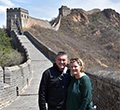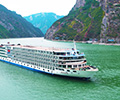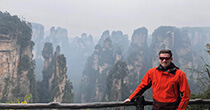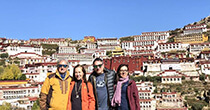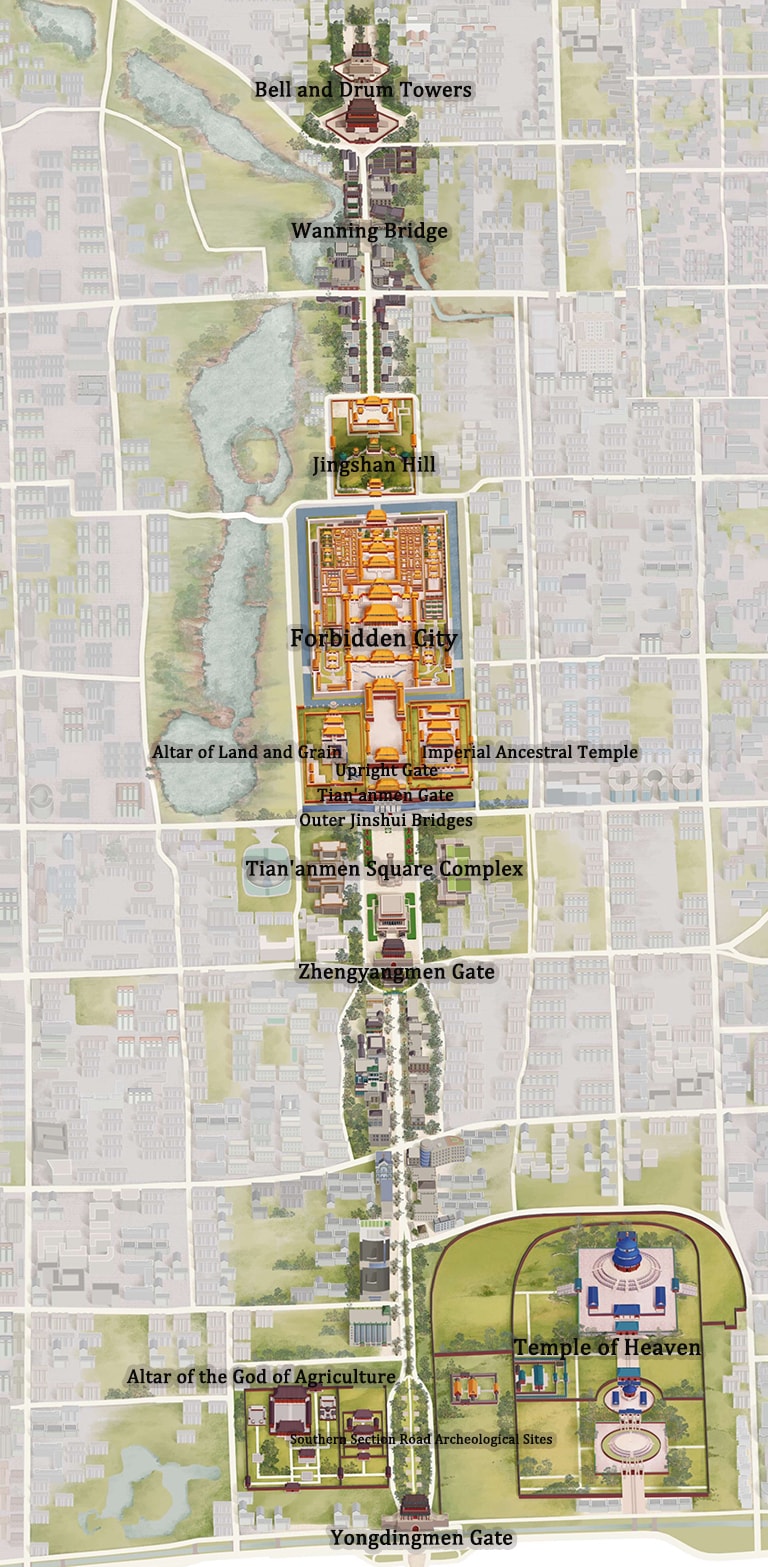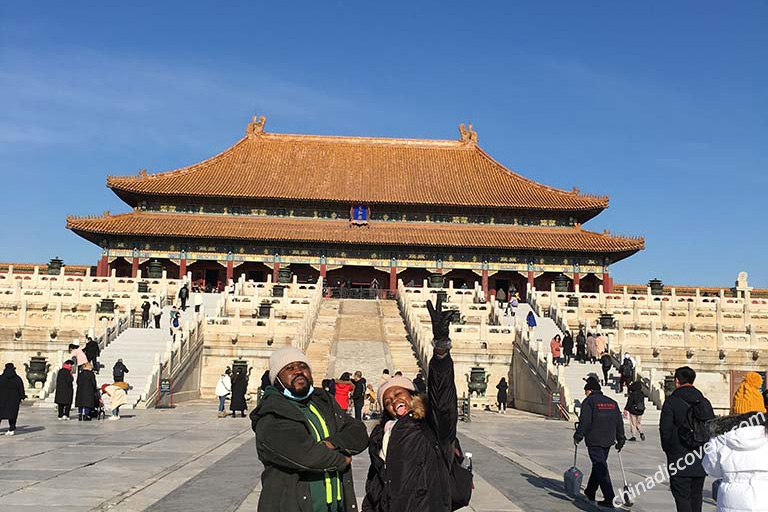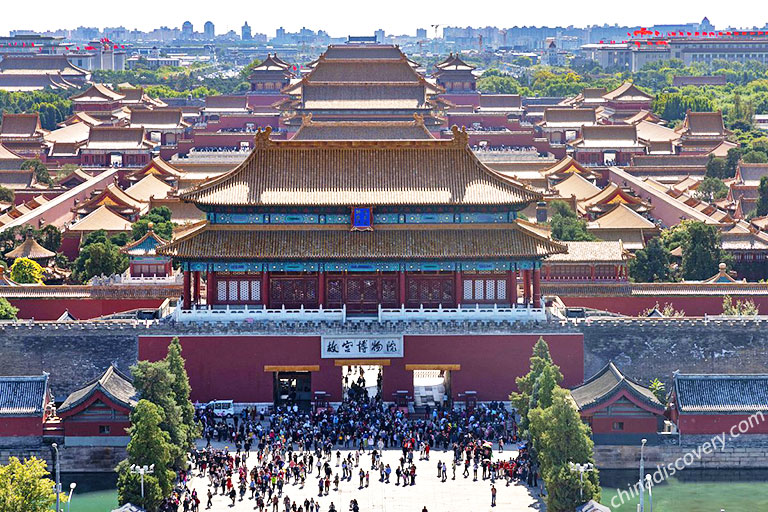Beijing Central Axis - A Building Ensemble Exhibiting the Ideal Order of the Chinese Capital
Beijing Central Axis, running north-south through the heart of the old city of Beijing and governing the overall layout of the capital, is an ensemble of building complexes and archeological sites, comprising 15 components. It contains imperial palaces and gardens, imperial sacrificial buildings, ancient city management facilities, national ceremonial and public buildings, and central axis roads remains. Initially constructed in the 13th century and shaped in the 16th century, Beijing Central Axis was continuously refined over seven centuries, giving rise to a well-organized and imposing building ensemble that manifests the ideal order of the Chinese capital deep rooted in the Chinese capital planning tradition for over two millennia.
Outstanding Universal Value by UNESCO
Beijing Central Axis, a building ensemble exhibiting the ideal order of the Chinese capital, was listed as a World Heritage Site in 2024 with supported by 15 nominated components. See UNESCO’s two criterions for inscribing the Beijing Central Axis on World Heritage Lists, reference from UNESCO Official Website (https://whc.unesco.org/en/list/1714/)
"Criterion (iii): Beijing Central Axis contributes significantly to the global history of urban planning, with its specific characteristics reflecting a cultural and political system developed in China during the imperial dynastic period. This urban planning tradition influenced the planning of other East and Southeast Asian capitals."
"Criterion (iv): Beijing Central Axis is an exceptionally well-preserved example of an urban ensemble developed based on an ancient urban planning theory, founded in Confucian principles related to a ritual dimension with city planning, politics, and governance. The principles of the Kaogongji have persisted in the Axis during the imperial dynastic period against the growth and urbanisation of Beijing, providing an illustration of a distinct urban pattern which represents a particular typology in the urban history of the world originated and developed during the imperial dynastic system in China."
Nowadays, the total number of World Heritage sites in Beijing has reached 8, including Beijing Central Axis, Great Wall, Forbidden City, Summer Palace, Temple of Heaven, Ming Tombs, The Grand Canal, and Peking Man Site at Zhoukoudian.
Top 15 Beijing Central Axis Spots
The 7.8-kilometer-long cityscape sequence of Beijing Central Axis contains contrasts and variations in a harmonious and unified order. The layout is symmetrical with proportional modal relationships, while the building designs are clear in their hierarchy of form, undulating in their scale and moderate in their spatial arrangement. Through traditional Chinese urban planning and architectural design, Beijing Central Axis presents an imposing and orderly overall spatial form. In this way they reflect the differences in hierarchy while forming an intrinsically ordered whole. Its spatial experience full of rhythmic variations and integrating ritual and music systems demonstrates the unique aesthetic pursuit and richness of Chinese culture and expresses the rite and order followed in capital planning practices of ancient times.
Yongdingmen Gate (永定门)
The Yongdingmen Gate was the southern portal of the outer city of Beijing during the Ming and Qing dynasties. It is the highest ranked of the seven gates in Beijing's outer city, exhibiting the superior status of the buildings on Beijing Central Axis and providing a unique testimony to the methods of traditional urban management during the Ming and Qing dynasties. The existing Yongdingmen Gate is a historical landmark for marking the site of the original Gate which was demolished in 1950s and rebuilt in 2005 strictly following the Principles for the Conservation of Cultural Heritage Sites in China. The location of the gate tower marks the position of Beijing Central Axis' southern end, exhibiting the traditional forms and architectural techniques applied in constructing city gate towers in ancient China. It is an essential scenic spot for viewing the landscape of the south section of Beijing Central Axis.
Location: 50 meters west of the intersection of Yongdingmen East Street and Yongdingmen Inner Street, Dongcheng District, Beijing (北京市东城区永定门东街与永定门内大街交叉口西50米)
Southern Section Road Archeological Sites (中轴线南段道路遗存)
The southern section of the central axis roads is a key link between well-arranged urban complexes and public spaces. It was on the route that had to be passed for national rituals and ceremonies during the Ming and Qing dynasties. The Southern Section Road Archeological Sites are the material evidence that irrefutably show the location, orientation, engineering techniques, and history of continuous use of the central roads, bearing witness to the state ritual traditions that has continued on Beijing Central Axis to this day.
Location: About 400 meters north of Yongdingmen Gate (永定门以北约400米)
Altar of the God of Agriculture (先农坛)
The Altar of the God of Agriculture sits west of Beijing Central Axis in symmetry to the Temple of Heaven on the east. This layout highlights the respect for and emphasis on rituals and order in Chinese capital city planning. As the largest existing ancient Chinese venue for imperial sacrificial ceremonies in honor of the God of Agriculture, the altar also reveals how traditional Chinese society showed respect for its agrarian culture. It is thus a carrier of the ceremonial traditions of the Ming and Qing dynasties that offered sacrifices to the God of Agriculture.
Location: Beijing Museum of Ancient Architecture, No. 21 Dongjing Road, Xicheng District, Beijing (北京市西城区东经路21号北京古代建筑博物馆)
Temple of Heaven (天坛)
The siting of the Temple of Heaven reflects the ancient Chinese cultural tradition of setting "sacrificial facilities in the southern suburb." Its location, planning pattern, and symmetrical east-west layout with the Altar of the God of Agriculture highlight the respect for and emphasis on rituals and order in Chinese capital city planning. They also give prominence to the dominant role of Beijing Central Axis in urban planning. The Temple of Heaven is China's largest and best-preserved Ming and Qing era building complex for heaven-worshiping ceremonies. Its architectural and landscape design exhibits the ancient Chinese worldview, making it a masterpiece of imperial architecture for ceremonial worship in ancient China and a carrier of national heaven-worshiping rituals and cultural traditions of the Ming and Qing dynasties. The Temple of Heaven ceased to be an imperial worship building in 1912. In 1918 it was opened as the Temple of Heaven Park to the public, a function it has served to this day.
Location: No. 1, Temple of Heaven Dongli, Dongcheng District, Beijing (北京市东城区天坛东里甲1号)
Ticket Price:
April 1st - October 31st (high season): CNY 15
November 1st - March 31st (low season): CNY 10
Opening Hours:
April 1st - October 31st: 06:00 ~ 22:00 (Last admission: 21:00)
November 1st - March 31st: 06:30 ~ 22:00 (Last admission: 21:00)
 Spectacular Landmark in Temple of Heaven - Qinian Hall
Spectacular Landmark in Temple of Heaven - Qinian Hall
 Our Guests from New Zealand Visiting Temple of Heaven in 2017
Our Guests from New Zealand Visiting Temple of Heaven in 2017
Zhengyangmen Gate (正阳门)
The Zhengyangmen Gate was a city gate complex for defensive purposes and with urban management functions during the Ming and Qing dynasties. As the central south gate of the inner city of Beijing in the Ming and Qing dynasties, the Zhengyangmen Gate is the largest and highest-ranked city gate among the gates of inner and outer cities, and has witnessed the traditional way of urban management in ancient China. It is one of the key viewpoints to enjoy a distant view of the Tian'anmen Square Complex and an important part of the landscape in the southern section of Beijing Central Axis.
Location: The north end of Qianmen Street, Dongcheng District, Beijing (北京市东城区前门大街北端)
 Amazing Night View of Zhengyangmen Gate
Amazing Night View of Zhengyangmen Gate
Tian'anmen Square Complex (天安门广场及建筑群)
Constructed in the Ming dynasty and extended in the mid-20th century, the Tian'anmen Square Complex is located at the heart of Beijing Central Axis and is an important example of its modern transformation. The square's planning respects and emphasizes the principle of the Axis' balance and symmetry. The architecture and landscape of the Tian'anmen Square Complex demonstrate China's efforts in modern times to explore and innovate on the national style in the design of public buildings in the mid-20th century. These interventions reflect important milestones in the progress of urban planning and architecture design in the modern era. Today, the Tian'anmen Square Complex is the preeminent venue for hosting state-level activities and cultural events as well as grand celebrations for the people. Ever since its inception, the square complex has witnessed the historical continuity of China's state ritual traditions.
Location: East Chang'an Street, Dongcheng District, Beijing (北京市东城区东长安街)
 Our Guests from New Zealand Visiting Tian'anmen Square in June, 2021
Our Guests from New Zealand Visiting Tian'anmen Square in June, 2021
Outer Jinshui Bridges (外金水桥)
The location of the Outer Jinshui Bridges strictly corresponds to five arched gateways of the Tian'anmen Gate, and south gates of the Imperial Ancestral Temple and the Altar of Land and Grain. The layout, width, and decorative details of the bridges all reflect the planning principle of "choosing the center". They have borne an important ceremonial function ever since their inception in the Ming and Qing dynasties, used for entering and exiting the imperial city and passing from the Forbidden City to the southern suburbs when the emperor went out to participate in worship ceremonies. Today, it is still an essential part of the ceremonial space where important state celebrations are hosted.
Location: Inside Tiananmen Square, East Chang'an Street, Dongcheng District, Beijing (北京市东城区东长安街天安门内)
 Our Guest from America Visiting Outer Jinshui Bridges in 2017
Our Guest from America Visiting Outer Jinshui Bridges in 2017
Tian'anmen Gate (天安门)
The Tian'anmen Gate was the main front gate of the imperial city during the Ming and Qing dynasties, leading to the palace city and forming a part of the imperial court area. It exhibits the ideal urban planning paradigm of "court in the front and market in the back" as prescribed in the Kaogongji (《考工记》). The Tian'anmen Gate was where the emperors of the Ming and Qing dynasties issued their imperial edicts. It has become a venue for major national events and a carrier of national rituals and stood witness to the end of the over 2,000-year dynastic system and the establishment of the People's Republic of China.
Location: North side of Chang'an Street, Dongcheng District, Beijing (北京市东城区长安街北侧)
 Our Guests from Mexico Visiting Tian'anmen Gate in 2019
Our Guests from Mexico Visiting Tian'anmen Gate in 2019
Upright Gate (端门)
The Upright Gate was an essential part of the leading space for ritual activities before entering and exiting the palace city and part of the imperial court. Together with the Tian'anmen Gate, the Upright Gate features a towering volume and a solemn style, highlighting dignity and divinity of central axis buildings in the palace city and the imperial city.
Location: South side of the Palace Museum, No. 4 Jingshanqian Street, Dongcheng District, Beijing (北京市东城区景山前街4号故宫博物院南侧)
Altar of Land and Grain (社稷坛)
The strictly symmetrical layout of the Imperial Ancestral Temple and the Altar of Land and Grain on Beijing Central Axis embodies the ideal capital city's planning paradigm as prescribed in the Kaogongji. The ancestral temple must be built on the left, while the altar of land and grain must be on the right. The Altar of Land and Grain is the most complete extant ancient imperial altar in China that was used to worship Tai She (the God of Land) and Tai Ji (the God of Grain). The altar reflected the comprehension and worship of land and the desire for the eternity of the country's sovereignty and territorial integrity in traditional Chinese culture. As the first imperial building turned into an urban park in Beijing, the Altar of Land and Grain reflects the transformation to the increased public accessibility of Beijing Central Axis.
Location: Zhongshan Park, No. 4 Zhonghua Road, Dongcheng District, Beijing (北京市东城区中华路4号中山公园)
Imperial Ancestral Temple (太庙)
The rigorously symmetrical layout of the Imperial Ancestral Temple and the Altar of Land and Grain on Beijing Central Axis embodies the ideal capital city's planning paradigm as prescribed in the Kaogongji. Serving the imperial families of the Ming and Qing dynasties, the Imperial Ancestral Temple is the material carrier of the Chinese cultural tradition of "worshiping the ancestors”. It is an essential building for national rituals and the most complete and largest extant building complex of ancestral worship by the imperial families. The Sacrificial Hall in the Imperial Ancestral Temple is a timber structure from the Ming dynasty. It is the highest-ranked construction of official architecture from the Ming and Qing dynasties, featuring an unprecedented scale of its kind, with exquisite materials, representing the highest accomplishment of the art of imperial architecture from this period.
Location: Beijing Working People's Cultural Palace, East Chang'an Street, Donghuamen Street, Dongcheng District, Beijing (北京市东城区东华门街道东长安街北京市劳动人民文化宫)
Forbidden City (故宫)
Located on Beijing Central Axis, the Forbidden City was the palace city of the Ming and Qing dynasties. Its location in relation with the old city of Beijing epitomizes the ancient Chinese concept of urban planning of "building the imperial palace at the central location". The imperial court area formed by the Tian'anmen Gate, the Upright Gate, and the Forbidden City, together with the Bell and Drum Towers in the north exhibit the urban planning paradigm of "court in the front, market in the back" as prescribed in the Kaogongji. The Forbidden City is an outstanding example of the imperial palace in China. The centered and symmetrical planning pattern and the well-ordered landscape demonstrate the principle of "choosing the center". It was a place where the imperial families hosted national celebrations, administered government affairs, and enjoyed daily activities. As a significant material carrier of national etiquettes and cultural traditions, the Forbidden City has witnessed the Chinese cultural tradition of inclusion and diversity. The establishment of the Palace Museum in 1925 marks an important step in the development of Beijing Central Axis toward public access, and the museum bears witness to the historical transformation of the Chinese society from a dynastic system into a modern state.
Location: No. 4, Jingshanqian Street, Dongcheng District, Beijing (北京市东城区景山前街4号)
Ticket Price:
April 1st - October 31st (high season): CNY 60
November 1st - March 31st (low season): CNY 40
Opening Hours:
April 1st - October 31st: 08:30 ~ 17:00 (Last admission: 16:00)
November 1st - March 31st: 08:30 ~ 16:30 (Last admission: 15:30)
Closed on Mondays except for Chinese Public Holidays
 Our Guests from America Visiting Meridian Gate in 2017
Our Guests from America Visiting Meridian Gate in 2017
 The Bronze Lion in front of the Gate of Supreme Harmony
The Bronze Lion in front of the Gate of Supreme Harmony
 Our Guest from Canada Visiting Hall of Supreme Harmony in 2017
Our Guest from Canada Visiting Hall of Supreme Harmony in 2017
Jingshan Hill (景山)
The Jingshan Hill is the tallest point and a key skyline node on Beijing Central Axis. Its position and relationship to the north of the Forbidden City demonstrate the planning concept of Chinese palaces and gardens. Its towering hill, picturesque garden, and ornate buildings enrich the architectural sequence of the Axis. With its unique garden landscape, the Jingshan Hill has dual functions for both sacrificial rituals and the artificially created mountain setting providing a high elevation from which to look out over the city. It testifies to the imperial ceremonial and ritual traditions carried out in the Qing dynasty.
Location: No. 44, Jingshan West Street, Xicheng District, Beijing (北京市西城区景山西街44号)
Ticket Price:
April 1st - October 31st (high season): CNY 10
November 1st - March 31st (low season): CNY 5
Opening Hours:
April 1st - October 31st: 06:00 ~ 21:00 (Last admission: 20:30)
November 1st - March 31st: 06:30 ~ 20:00 (Last admission: 19:30)
 Panoramic View of the Southern Central Axis from Jingshan Hill
Panoramic View of the Southern Central Axis from Jingshan Hill
 Panoramic View of the Northern Central Axis from Jingshan Hill
Panoramic View of the Northern Central Axis from Jingshan Hill
Wanning Bridge (万宁桥)
The Wanning Bridge is the oldest bridge on Beijing Central Axis. Its location and function have remained unchanged for over seven centuries. The structure contains layered information from various periods of history and provides vital material evidence of the superimposed relationship of Beijing Central Axis between the Dadu of the Yuan dynasty and the capital of the Ming and Qing dynasties as well as modern China.
Location: 20 meters south of the intersection of Di'anmenwai Street and Mao'er Hutong, Xicheng District, Beijing (北京市西城区地安门外大街与帽儿胡同交叉口南20米)
Bell and Drum Towers (钟鼓楼)
Being the landmarks of the northern end of Beijing Central Axis in the commercial district of the old city, the Bell and Drum Towers, together with the Tian'anmen Gate, the Upright Gate and the Forbidden City, form a paradigm of the imperial court area of capital city planning, embodying "court in the front, market in the back" as prescribed in the Kaogongji. The magnificent statures of the Bell and Drum Towers contrast with the surrounding low-lying residential buildings with their gray walls and tiled roofs, presenting an important viewpoint of Beijing Central Axis. The towers were significant city management facilities for time keeping and announcing the time during the Ming and Qing dynasties, bearing witness to the traditional way of life.
Location: Zhonglouwan, Dongcheng District, Beijing (北京市东城区钟楼湾)
Ticket Price:
Bell Tower Ticket: CNY 10
Drum Tower Ticket: CNY 20
Opening Hours:
March 26th - October 25th: 09:30 ~ 17:30 (Last admission: 17:20)
October 26th - March 25th: 09:30 ~ 16:30 (Last admission: 16:20)
 The Traditional Bell Tower on the Beijing Central Axis
The Traditional Bell Tower on the Beijing Central Axis
 The Traditional Drum Tower on the Beijing Central Axis
The Traditional Drum Tower on the Beijing Central Axis
Beijing Central Axis Visiting Route
Sacrificial Building Complexes in the Southern Suburbs visiting route (about 7 hours): Southern Section Road Archeological Sites - Altar of Circular Mound Complex - Imperial Vault of Heaven Complex - Red Stairway Bridge and North Clothes Changing Platform - Altar of Prayer for Grain Complex - Hall of Imperial Zenith Complex - Palace of Abstinence Complex - Divine Music Administration Complex - Hall of the God of the Year Complex - Altar of the God of Agriculture - Plowing Viewing Platform, Dressing Hall, and Ceremonial Farmland - Hall of the God of the Year Complex - Yongdingmen Gate
Tiananmen Square Complex visiting route (about 4 hours): Tian’anmen Gate - Outer Jinshui Bridges - Monument to the People’s Heroes - Great Hall of the People - National Museum of China - Chairman Mao Memorial Hall - Zhengyangmen Gate Tower - Zhengyangmen Archery Tower
Imperial Ancestral Temple and the Altar of Land and Grain visiting route (about 2.5 hours): Imperial Ancestral Temple - Sacrificial Hall - Resting Hall - Distant Kin Temple - Halberd Gate - Worship Hall - Altar of Land and Grain
Imperial Palaces and Gardens visiting route (about 6 hours): Upright Gate - Meridian Gate - Gate of Supreme Harmony - Hall of Supreme Harmony - Hall of Central Harmony - Hall of Preserving Harmony - Gate of Heavenly Purity - The Hall for Ancestral Worship Complex - Palace of Heavenly Purity - Hall of Union - Palace of Earthly Tranquility - Imperial Garden - Gate of Divine Prowess - Qiwang Belvedere - Jingshan Hill - The Hall of Imperial Longevity Complex
Commoners’ Neighborhoods visiting route (about 2 hours): Bell Tower - Drum Tower - Wanning Bridge
How to plan your Beijing trip
To explore the Beijing Central Axis including Forbidden City, Temple of Heaven and Tiananmen Square and other highlights of Beijing, like Great Wall, Summer Palace and Hutongs, you need at least 3 or 4 full days, which is available up to 144 Hours Visa-free for Transit in Beijing. If you have more days, you can go for an in-depth Great Wall hiking or photography, and explore more hidden attractions in Beijing. We have helped many global travelers enjoy their memorable wonderful trips to Beijing for the past few years. You can find your favorite tour package from our valuable Beijing private tours collections.
As the most popular transportation hub in China, you can easily travel from Beijing to any other hot travel destinations in China by flight or train, such as Xian, Shanghai, Guilin, Zhangjiajie, Chengdu and other popular destinations in China. China Discovery has designed many great China tour packages from Beijing for you. Please make your choice from our collections or let us customize one for you.
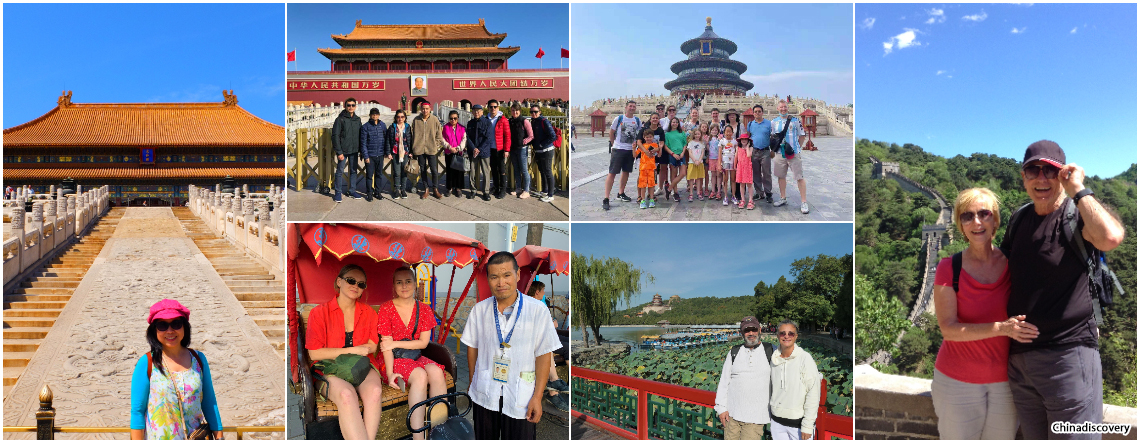
Our Delighted Customers in Beijing
Keep Reading About Beijing Attractions
- Great Wall of China
- Mutianyu Great Wall
- Jinshanling Great Wall
- Forbidden City
- Summer Palace
- Temple of Heaven
- Tiananmen Square
- 798 Art District
- Jingshan Park
- Beijing Hutong
- National Museum of China
- Gubei Water Town
- Lama Temple
- Yandaixie Street
- Nanluoguxiang
- Beijing Olympic Park
- Old Summer Palace
- Badaling Great Wall
- Huanghuacheng Great Wall
- Simatai Great Wall
- Juyongguan Great Wall
Top Beijing Tours & Travel Guide
- Forbidden City Tours
- Popular Beijing Tours
- Great Wall Hiking Tours
- Beijing Visa Free Tours
- Beijing Layover Tours
- Tpo 6 Beijing Vacations
- Beijing Family Tours
- Beijing Travel Guide
- Beijing Travel Articles
- Great Wall Trip Planning Guide
- How to Plan a Beijing Trip
- Things to do in Beijing
- Top Experiences Recommended by LP
- Featured Activities in Beijing
- How to Get to & around Beijing
- Weather & Seasons in Beijing
- Beijing Maps
- Beijing 144/24 Hour Visa Free
- Recommended Hotels in Beijing
- Beijing Photo Gallery
- Top Beijing Food and Snacks
- Beijing Shopping
- Beijing Nightlife
- Beijing FAQs & Tips
- Forbidden City Travel Tips
- Forbidden City Facts
- Forbidden City Map
- Hall of Supreme Harmony
- Imperial Garden
- Nine-dragon Screen
- The Gallery of Clocks
- The Treasure Gallery
- Palace Museum Collections
- How to Visit the Forbidden City
- Forbidden City Photography Tips
- Forbidden City Weather & Seasons
- How to Book Forbidden City Tickets
- How to Get to Forbidden City
- How to Transfer from Beijing Airports
Recommended Beijing Tours
Top 3 Beijing tours chosen by most customers to explore Beijing in the best way. Check the detailed itinerary, or tailor your own trip now with us.
Start planning your tailor-made holiday to China by contacting one of our specialists. Once inquired, you’ll get a response within 0.5~23.5 hours.
Customize a TripHave a question? Get answers from our travel experts or guests
- Your Question:
- Your Name:
- Your Email:
- Submit











